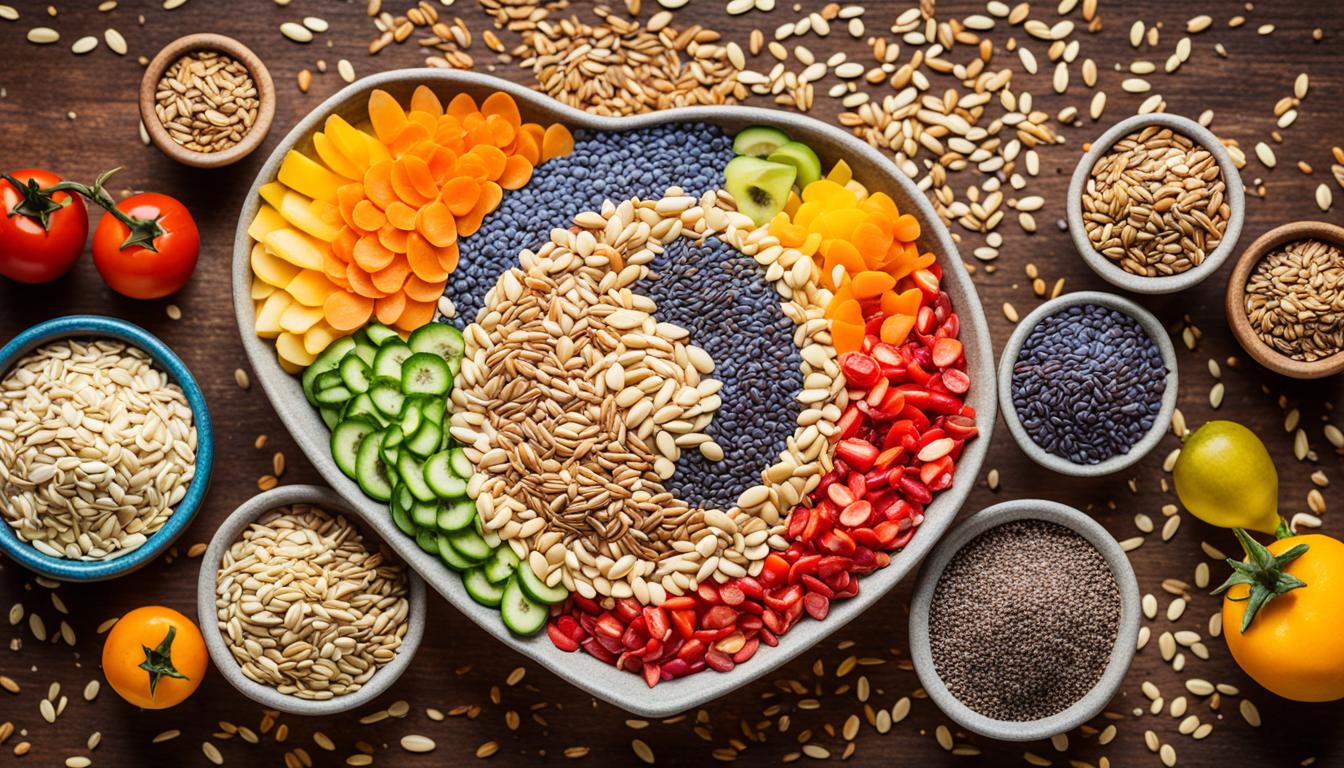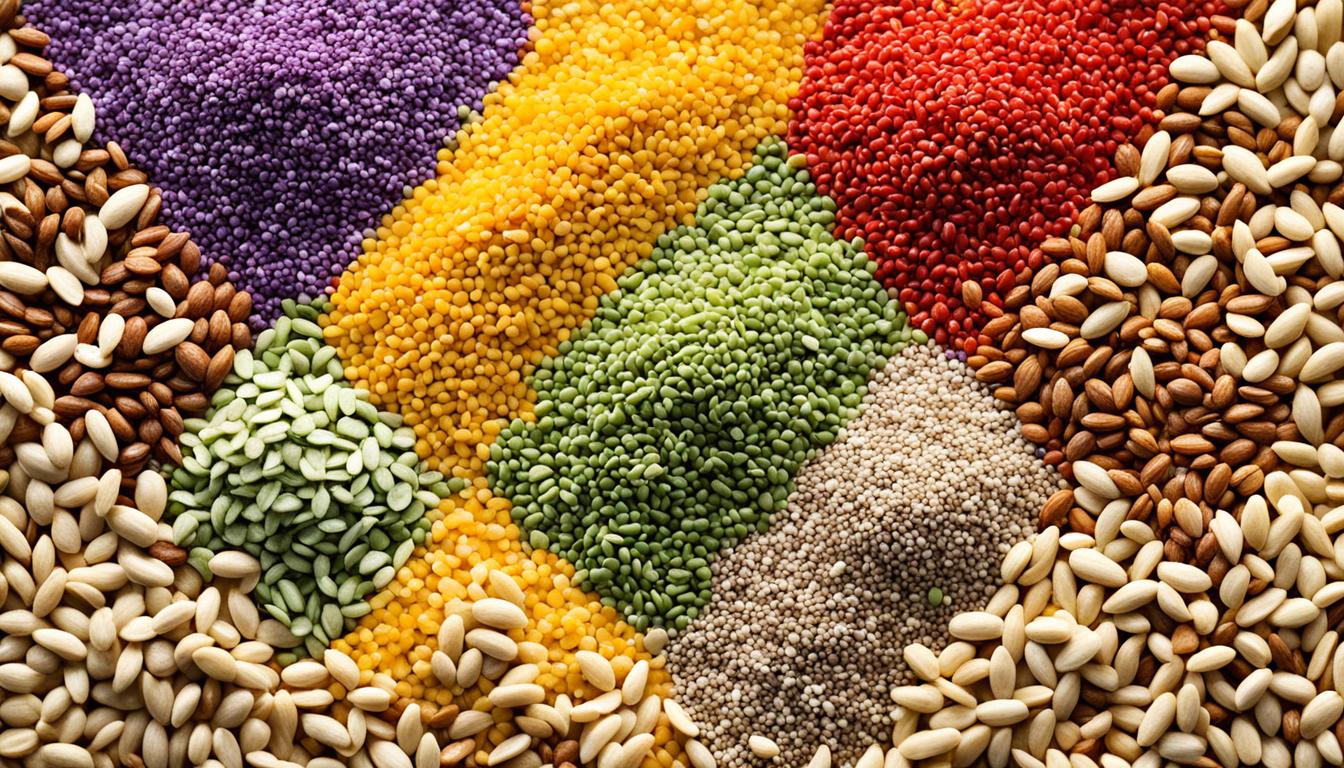Tomatoes are a major dietary source of the antioxidant lycopene. Lycopene helps reduce the risk of heart disease and some cancers. Tomatoes are not just tasty; they are packed with vitamins, minerals, and other good things for your health, making them a must in your diet.
Tomatoes come in many colors, shapes, and flavors. You can find everything from red beefsteak to orange heirlooms and sweet cherry tomatoes. This variety means there’s a tomato out there for everyone. In this article, we’ll explore the world of tomato nutrition and why they stand out in the produce aisle.
Key Takeaways
- Tomatoes are a major dietary source of the antioxidant lycopene, which has been linked to reduced heart disease and cancer risk.
- Tomatoes are an excellent source of vitamins C, K1, and folate, as well as the minerals potassium and magnesium.
- The carbohydrates in tomatoes are primarily simple sugars and insoluble fibers, making them a low-calorie, low-glycemic fruit.
- Consuming tomatoes and tomato-based products can offer benefits for skin health, brain function, and diabetes management.
- Tomato varieties can differ significantly in terms of sweetness, acidity, size, and seed content, providing a diverse culinary experience.
Introduction to Tomatoes
Tomatoes come from the nightshade family, and they’re originally from South America. Even though they’re technically a fruit, we mostly use them like a vegetable. You can find tomatoes in many colors, shapes, and tastes. There are a lot of subtypes to discover.
What Are Tomatoes?
Tomatoes grow on the Solanum lycopersicum plant in the nightshade family. They first came from South America. Later, they spread to Europe and the whole world. Now, there are many kinds of tomatoes all over.
Botanical Classification: Fruit or Vegetable?
By science, tomatoes are a fruit. This is because they grow from a plant’s flower part and have seeds. But, we consider them a vegetable for cooking. They add flavor to normal dishes, not just sweets.
Tomato Nutrition Facts and Composition
Tomatoes are packed with water, about 95%. The rest, 5%, is mostly carbs and fiber. A little raw tomato, about 100 grams, has 18 calories, 0.9 grams protein, 3.9 grams carbs, and 0.2 grams fat.
Calorie and Macronutrient Content
In terms of tomato calories, they’re pretty low. A small, raw tomato has just 18 calories. These calories mostly come from simple sugars and fiber. It has 3.9 grams of carbs, including 2.6 grams of sugar, and 1.2 grams of fiber.
Vitamins and Minerals in Tomatoes
Tomatoes supply key tomato vitamins and minerals. This includes 28% of your daily vitamin C in one medium-sized tomato. You also get potassium, vitamin K1, and folate. The vitamin C in tomatoes helps our immune system and skin.
Powerful Plant Compounds in Tomatoes
Tomatoes are packed with good plant compounds. These make them very good for you. Key compounds in tomatoes are lycopene, beta-carotene, naringenin, and chlorogenic acid.
Lycopene: The Star Antioxidant
Lycopene is a standout in tomatoes. It’s a strong antioxidant. You mainly find it in the tomato’s skin. Ripe tomatoes, which are red, have more tomato lycopene.
Ketchup, juice, paste, and sauces are top sources of lycopene. They give the U.S. over 80% of its dietary lycopene.
Other Beneficial Compounds
Tomatoes not only have lycopene. They also have beta-carotene, naringenin, and chlorogenic acid. These help as antioxidants. They add to tomatoes’ health benefits.
tomatos nutrition facts
Tomatoes are low in calories, with a small (100-gram) raw tomato containing only 18 calories. The carbohydrate content of tomatoes mainly has simple sugars and fibers. A 100-gram tomato has 3.9 grams of carbs, 2.6 grams of sugar, and 1.2 grams of fiber. They are rich in several vitamins and minerals like vitamin C, potassium, vitamin K1, and folate.
| Nutrient | Amount per 100g |
|---|---|
| Calories | 18 |
| Protein | 0.9g |
| Carbohydrates | 3.9g |
| Sugar | 2.6g |
| Fiber | 1.2g |
| Fat | 0.2g |
Tomatoes are a great source of tomato nutrition facts. They provide many tomato calories and tomato macronutrients that are good for a balanced diet.
Health Benefits of Tomatoes
Tomatoes and products made from them can make your skin healthier. They can lower the chances of getting heart disease and cancer. Eating them may make your heart health better. This is because they improve inflammation and stress on the heart. The antioxidants in tomatoes, like lycopene, can lower certain cancer risks.
Heart Health Promotion
In 2022, a study said eating lycopene could decrease heart disease risk by 14%. Another research from 2014 showed that drinking tomato juice daily could help. It increased good cholesterol (HDL) and decreased bad cholesterol (LDL). Plus, it made insulin levels better. These results show how tomatoes can benefit your heart.
Cancer Prevention Properties
Recent studies point towards lycopene’s ability to help against cancer. A 2017 study said drinking tomato juice can lower prostate cancer risk. In men with fertility issues, it boosted blood lycopene and sperm movement. A 2022 review also noted lycopene’s role in reducing heart disease risk.
Skin Health Benefits
Lycopene and other plant nutrients in tomatoes can help protect against sunburn. They are good for your skin. Eating tomatoes can help your skin cope with damage from the sun and environment.
Tomato Ripening and Flavor
Tomatoes become tastier and better when they ripen naturally. Many store-bought tomatoes are picked early and then ripened with gas. This way, they look red even if they’re not fully ripe. Sadly, this can mean they don’t have their full flavor.
Commercial Ripening Process
The way tomatoes are ripened for stores isn’t always the best for flavor. They use a gas called ethylene to turn them red. This process aims to keep them looking good for longer on store shelves. But it can take away from their taste.
Enhancing Tomato Flavor at Home
Locally grown tomatoes that get ripe on the vine taste much better. At home, you can make store-bought tomatoes taste fresher. Just wrap them in newspaper and let them sit on the counter. Check if they’re ready every day. This method brings out a more vibrant taste in the tomatoes.
Safety and Potential Side Effects
Most people do just fine with tomatoes. A tomato allergy is quite rare. But, if you’re allergic to grass pollen, watch out. You might get an oral allergy syndrome. This can cause your mouth to itch, throat to feel scratchy, or mouth and throat to swell. If you’re allergic to latex, you might also react bad to tomatoes.
If you have health issues like heartburn (GERD) or frequent migraines, tomatoes might not be your friends. They could make these conditions worse.
Varieties and Forms of Tomatoes
Tomatoes are not all the same. They come in many varieties and forms. Each one has its own taste, feel, and best use in cooking. You can find tiny cherry and grape tomatoes, as well as big beefsteak and tasty heirloom ones.
Along with fresh tomatoes, there are also processed types. These include canned, paste, juice, and sun-dried. The taste of tomatoes, like how sweet or sour they are, can change. This depends on where and how they were grown, and when they were picked.
| Tomato Variety | Approximate Size (grams) | Calories | Fiber (grams) |
|---|---|---|---|
| Cherry Tomato | 17 | 3 | – |
| Grape Tomato | 8 | 1 | – |
| Roma Tomato | 62 | 11 | 1 |
| Beefsteak Tomato | 182 | 33 | 2 |
| Heirloom Tomato | 123 | 22 | – |
| Tomato on the Vine | 123 | 22 | – |
| Green Tomato | 123 | 28 | – |
The variety in tomato types lets us use them in many dishes. You can use them in salads, sauces, or fry them. Knowing about the different kinds of tomatoes can make your cooking more interesting and tasty.
Selecting and Storing Tomatoes
When how to select tomatoes, choose ones that are plump and firm. They should have smooth, shiny skin and be the same color. Steer clear of any with cuts, bruises, or mold. For the best taste and freshness, pick local, in-season tomatoes from the farmer’s market.
Contrary to what many think, avoid putting fresh how to store tomatoes in the fridge. It can make the texture tough and lessen the taste. Keep them in a cool, dry spot at home. After cutting, you should put them in the fridge and eat them soon. This keeps their flavor and texture.
Tomatoes are key in the world’s kitchens, whether you see them as fruit or veggie. In the US alone, people eat over 12 million tons yearly. The top season runs from June to September, mainly from California and Florida. Come summer, South Carolina’s tomatoes are a must-try.
Beefsteak tomatoes are classic choices. They are big, red, juicy, and meaty. Packed with vitamins A and C, a pound is about 2 cups when chopped. Store ripe ones in the fridge for 2-3 days. Green tomatoes will ripen in 14-28 days indoors, depending on how warm it is.
Cooking and Incorporating Tomatoes into Meals
Tomatoes are great in many recipes, both fresh and cooked. Try sautéing, grilling, or roasting them to make their taste pop. Roasting makes them sweeter and adds depth to their flavor. You can eat roasted tomatoes alone or blend them into a sauce.
Use tomato sauce, salsa, and chutneys to make dishes like spaghetti and chili tastier. For something more filling, stuff big tomatoes with meat, rice, and spices.
Cooking tomatoes changes the nutrients they offer. For example, cooking boosts how well your body can use lycopene. This is an antioxidant that’s really good for you.
No matter how you use tomatoes, your meals will get a health boost. They are loaded with vitamins, minerals, and powerful plant nutrients. These are all great for your health.
Conclusion
Tomatoes are not just tasty; they’re good for us. They’re packed with the antioxidant lycopene. This helps fight off heart disease and some cancers.
Tomatoes might not agree with everyone, though. Allergic reactions and bad reflux can happen. It’s also tricky for those on certain meds or with kidney issues. For them, eating tomatoes should be limited.
But for most people, tomatoes are a great choice. They’re easy to add to any meal. And they offer lots of health perks. So, eat up and enjoy the benefits!
FAQ
What are the health benefits of tomatoes?
What are the key nutrients in tomatoes?
How do tomatoes compare to other fruits and vegetables in terms of nutrition?
What are the different types and forms of tomatoes?
How should tomatoes be stored and selected for optimal quality?
Are there any potential side effects or safety concerns with consuming tomatoes?
Source Links
- https://www.healthline.com/nutrition/foods/tomatoes
- https://www.verywellfit.com/tomatoes-nutrition-facts-calories-and-health-benefits-4119981
- https://www.health.com/nutrition/health-benefits-tomatoes
- https://www.medicalnewstoday.com/articles/273031
- https://www.everydayhealth.com/diet-nutrition/tomatoes/guide/
- https://www.healthline.com/nutrition/types-of-tomatoes
- https://nourishcookingco.com/blogs/blog/tomatoes-health-benefits-nutrition-facts-how-to-select-store-prepare
- https://hgic.clemson.edu/factsheet/using-storing-tomatoes/
- https://www.pritikin.com/your-health/healthy-living/eating-right/food-of-the-month-tomatoes.html
- https://www.healthifyme.com/blog/benefits-of-tomatoes/
- https://www.healthline.com/nutrition/cherry-tomatoes




